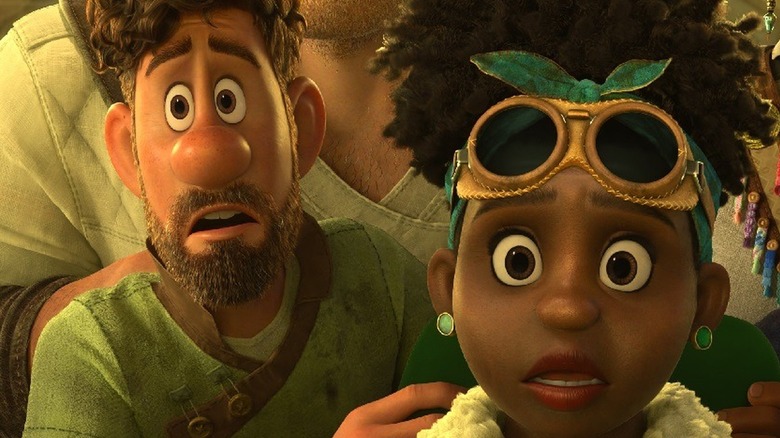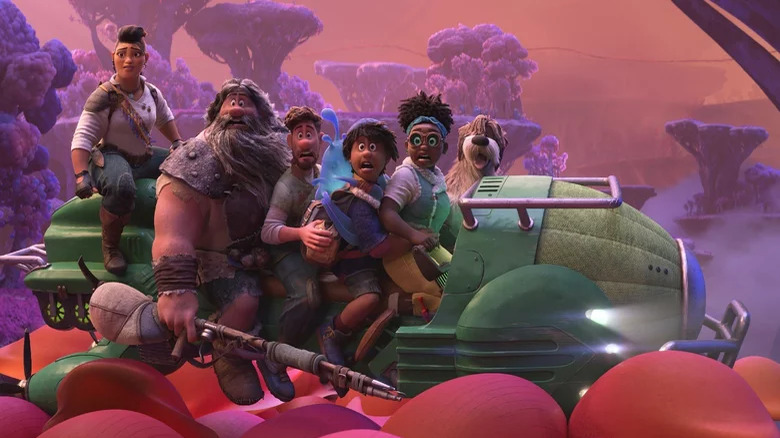Why The Strange World Creators Avoided Steampunk Aesthetics Despite The Film's Retro Pulp Origins - Exclusive
The town of Avalonia, the locale for Disney's newest animated feature "Strange World," goes through a lot of changes in the film's breezy 102-minute runtime. The film follows Avalonia's Clade family, where adventurous patriarch Jaeger Clade (Dennis Quaid) goes into the community's surrounding mountains to see what's on the other side. When he doesn't come back for over two decades, his son Searcher (Jake Gyllenhaal) has since changed Avalonia's future with the discovery of Pando, a plant that grants Avalonia the gift of electricity. When Avalonia's Pando supply starts to exhibit unusual problems, it's up to the Clades to go where no one's gone before to get to the bottom of the crisis in an imaginative and creative cinematic outing.
We watch a series of changes in Avalonia as the town's technology continues to evolve. Just like in world history, these technological changes produce a wide array of major social and architectural shifts. Despite the pulpy origins of the film, it's interesting to note what isn't in Avalonia's historical development.
A lot of pulp-inspired alternative history tales pin steam power as the impetus of alternative history and its unique technologies, and here "Strange World" stands apart. In a new exclusive interview with producer Roy Conli, he explains the thought process and intellectual origins behind Avalonia's decidedly non-steampunk development, conjuring alternative histories of a decidedly different stripe.
In the development of "Strange World," inspiration was taken from the literary tradition of the pulp tradition of yore, along with the early sci-fi writers who inspired those classic pulpy stories. With Avalonia, Conli explains, "we wanted to make sure that it was a world unlike any world that we've ever seen." Conli notes that "we were using these 19th-, early-20th-century stories by Jules Verne and H.G. Wells and whatnot as an inspiration" in Avalonia's design.
Sidestepping steampunk in Strange Worlds
Director Don Hall noted about the influences of "Strange World" that, when following the technological inventions of pulp literature, they boast "really inventive, really interesting vehicles and machines." At the same time, your standard cars were off the agenda.
"We wanted to take inspiration from that and build a world that didn't have terrestrial cars," Hall said. "They had to fly in these airships, but it was all based on dirigible technology with propellers." Why? "It was fun, it was whimsical, and [it] evoke[d] the feeling from those early adventure and science fiction novels," Hall explains.
The one design possibility that the "Strange World" creators took off the agenda? Despite its ever-popular nature with alternative history buffs and fictional dirigible fanatics alike – steampunk. Conli notes that "we didn't want steampunk, because steampunk is essentially a dirty, gritty world because they're using coal to boil water that makes steam."
While it's easy to think of steam-powered technology as hypothetically clean due to its use of water, the use of coal does put a grimy, dirty haze over, well, everything, which would be a deep contrast against the evergreen look of Avalonia's world. More importantly, it wouldn't work with the discovered source of Avalonia's technology, Pando. By contrast to coal, "Pando was essentially a pure force," a green technology until the problems occurred. The aesthetics of steampunk just wouldn't work in Avalonia.
The end result is a unique feeling world that has the dirigible vibes of classic pulp literature but without the steampunk griminess that often characterizes the genre, creating a world well worth exploring.
"Strange World" is available in theaters.

